Why The Preferment Stage Is Essential for Better Sinless Sourdough
The Preferment Stage is an essential part of both Fiber Flora and Lifestyle Lina recipes, helping to develop flavour and structure in your low-carb sourdough bread. This step creates a crucial foundation for your baking success with these recipe types. However, Discard Diva recipes skip this stage entirely, as they’re designed to use your sourdough discard directly without prefermentation.
What Wheat Flour Should I Choose?
You can use either white flour or whole wheat and whole grain flours in your preferment. Just remember that the heavier the flour, the more dense your breads and baked goods will be.
For the Fiber Flora Series, you can choose between a variety of wheats, from white flour to whole grain, ancient grain, or sprouted. This versatility allows you to customize the density and nutritional profile of your breads.
For the Lifestyle Lina series of breads and baked goods, the recipes call for a 00 pizza flour with the finest texture. This is the ideal flour for these recipes because the series is based on producing breads and baked goods that are lighter in texture.
Whole grain flours contribute excellent nutrition and flavour depth, but they typically create a more substantial texture compared to white flour, which tends to produce lighter, airier results.
Creating Your Preferment
In a glass container, combine:
- 1 cup of your living sourdough starter (oat fiber + vital wheat gluten or almond flour + coconut flour)
- 1 cup of wheat flour (your choice)
- 1/2 cup of spring water
- 2 tablespoons of olive oil
- 1 teaspoon sugar or honey for low-carb flours*
Mix thoroughly until you have a smooth dough that doesn’t stick to the sides. Cover the container and place it in the warmest spot in your kitchen.
*Adding a small amount of sugar or honey helps boost fermentation in low-carb flour. The yeast will eat all this sugar during fermentation, so you don’t need to count it in your carb totals.
We Are Using Wheat Flour?
The wheat flour in the preferment builds the essential foundation for delicious low-carb sourdough that truly captures traditional bread’s best qualities. It’s worth noting that while wheat flour is included in your Sinless Sourdough recipes, the carbohydrates are naturally reduced during the preferment fermentation process, and any remaining carbs are further balanced by the other low-carb ingredients used in the dough recipes. This careful approach allows you to enjoy authentic sourdough texture and flavour while maintaining your low-carb lifestyle.
Even in low-carb sourdough, wheat flour in the preferment helps:
- Boost fermentation with its natural enzymes and nutrients
- Develop deeper, more complex flavours
- Create better texture in the final bread
- Improve digestibility by breaking down complex carbohydrates
- Increase nutrient availability
- Reduce phytic acid, which can interfere with mineral absorption
Why Preferment Matters
The preferment stage serves two main purposes:
- Developing flavour
- Improving dough structure
This is typically the only stage where wheat flour is used (the carbs are balanced by other low-carb ingredients in the final dough).
Why Improving Dough Structure is Important
Good dough structure is essential for successful sourdough bread for several key reasons:
- It Supports the Rise: When your dough has proper structure, it can hold onto the gas bubbles produced during fermentation. The gluten network works like a series of chains forming a web that captures and holds all those gas bubbles in an even formation. Without good structure, these bubbles escape and your bread falls flat instead of rising beautifully.
- It Creates Better Texture: The structure of your dough directly affects the crumb of your finished bread. A well-structured dough helps create that perfect balance of airy holes throughout your loaf. When the structure is weak, you end up with either a dense, gummy bread or bread with inconsistent holes.
- It Makes Shaping Easier: Good dough structure makes the bread easier to handle and shape. A well-developed gluten network gives the dough elasticity and strength, so it holds its shape during proofing and baking.
- It Improves Oven Spring: Increased extensibility helps the dough expand and fill with gases, resulting in a light and airy loaf. When your dough has good structure, it can expand dramatically during those first minutes of baking.
- It Affects Flavour Development: A properly structured dough ferments more evenly, allowing the complex flavours to develop throughout the entire loaf.
In low-carb sourdough baking, achieving good structure is even more challenging since many low-carb ingredients lack gluten. This is why the preferment stage with wheat flour is so valuable.
How Long Should You Preferment?
Preferment time affects flavour:
- 12-24 hours: milder tangy taste
- 24-48 hours: deeper, more complex tangy flavour
For longer fermentation, start at room temperature for 24 hours, then move to the fridge to slow the process. Before using, let it sit at room temperature for 2-3 hours to wake up the yeast.
What’s Happening in Your Preferment?
During prefermentation, several important processes occur:
- Starches break down into simpler sugars
- Bacteria produce acids, creating that tangy flavour
- Proteins break down, improving texture
- Bacteria create compounds that enhance texture and shelf life
- Complex flavours begin to develop
